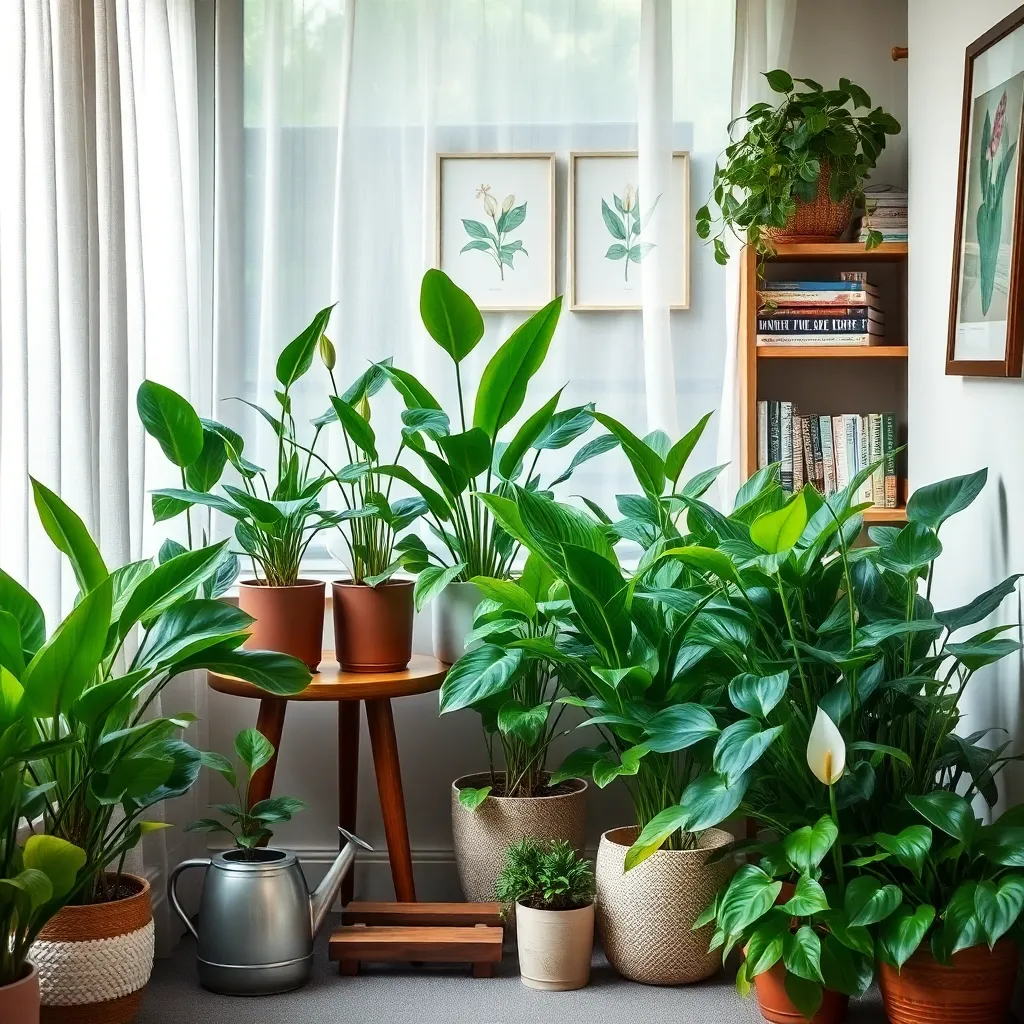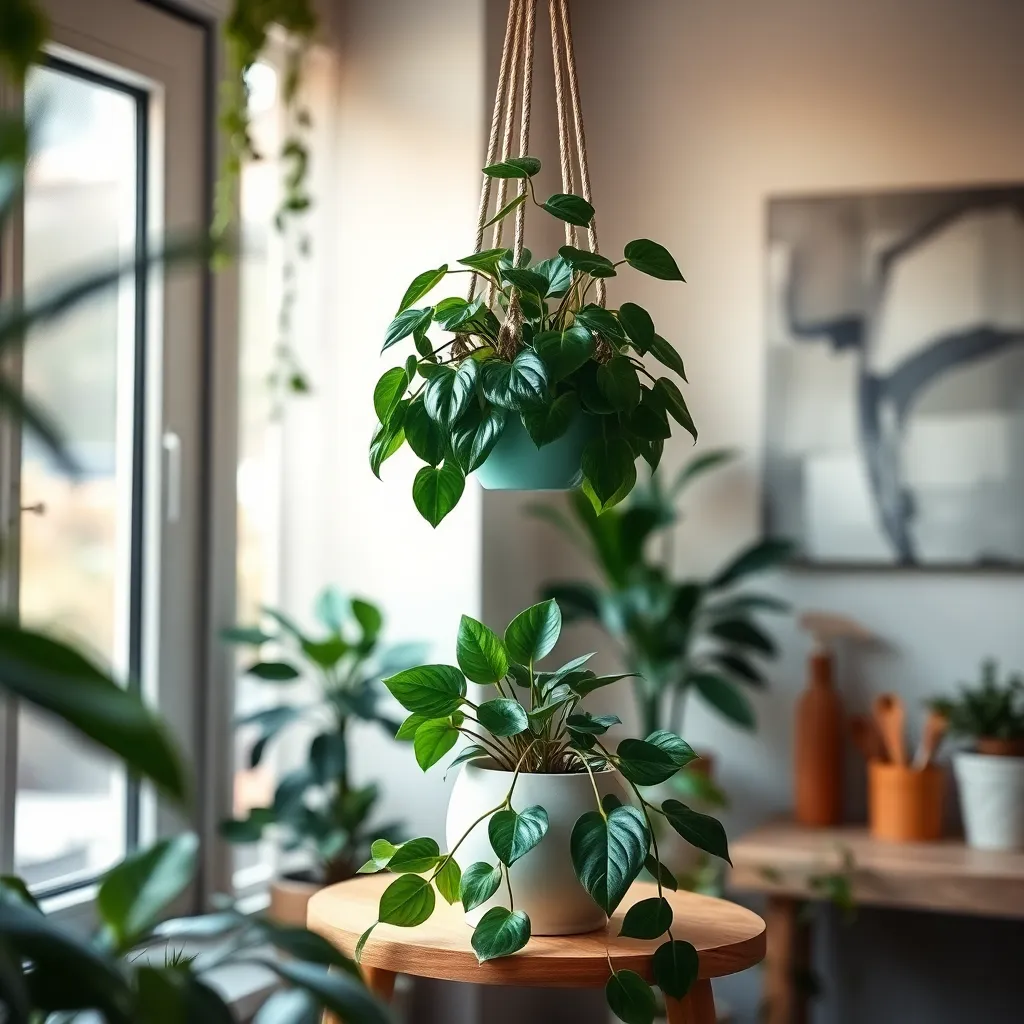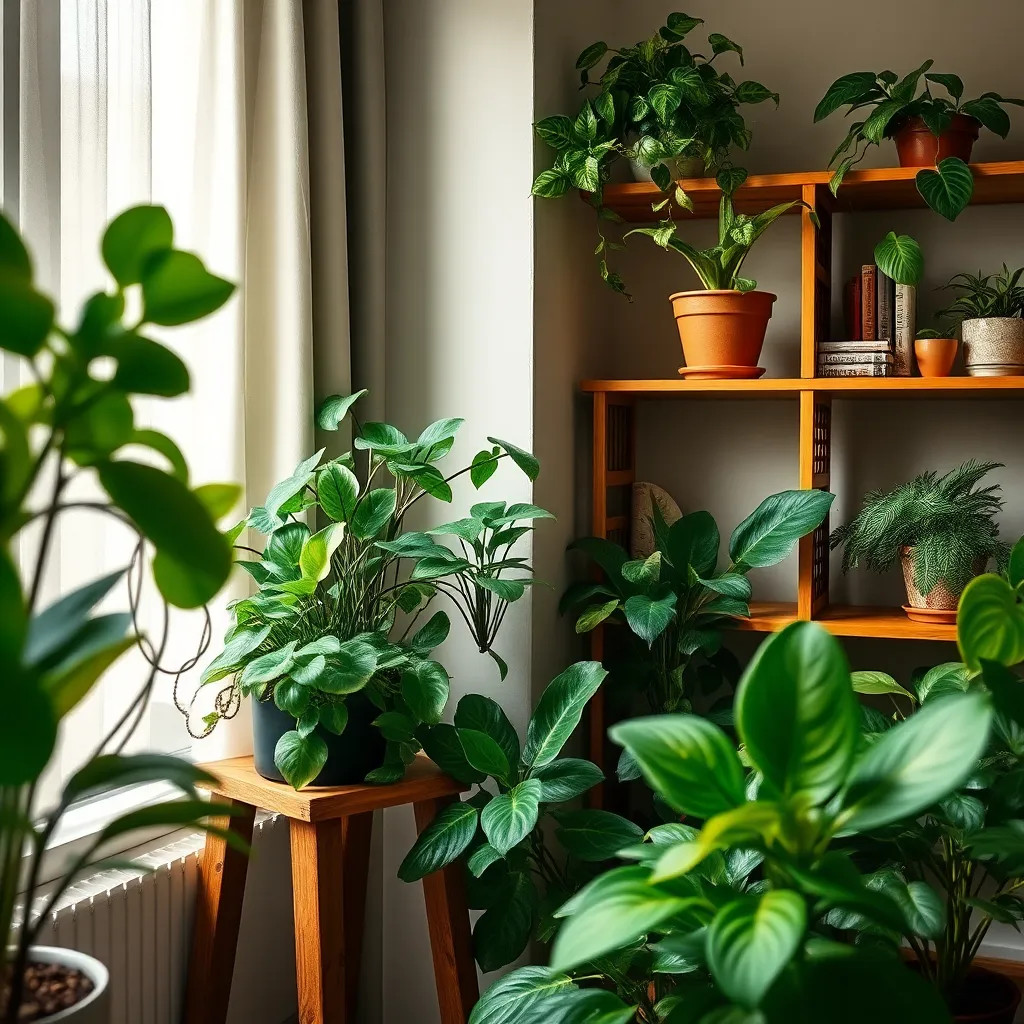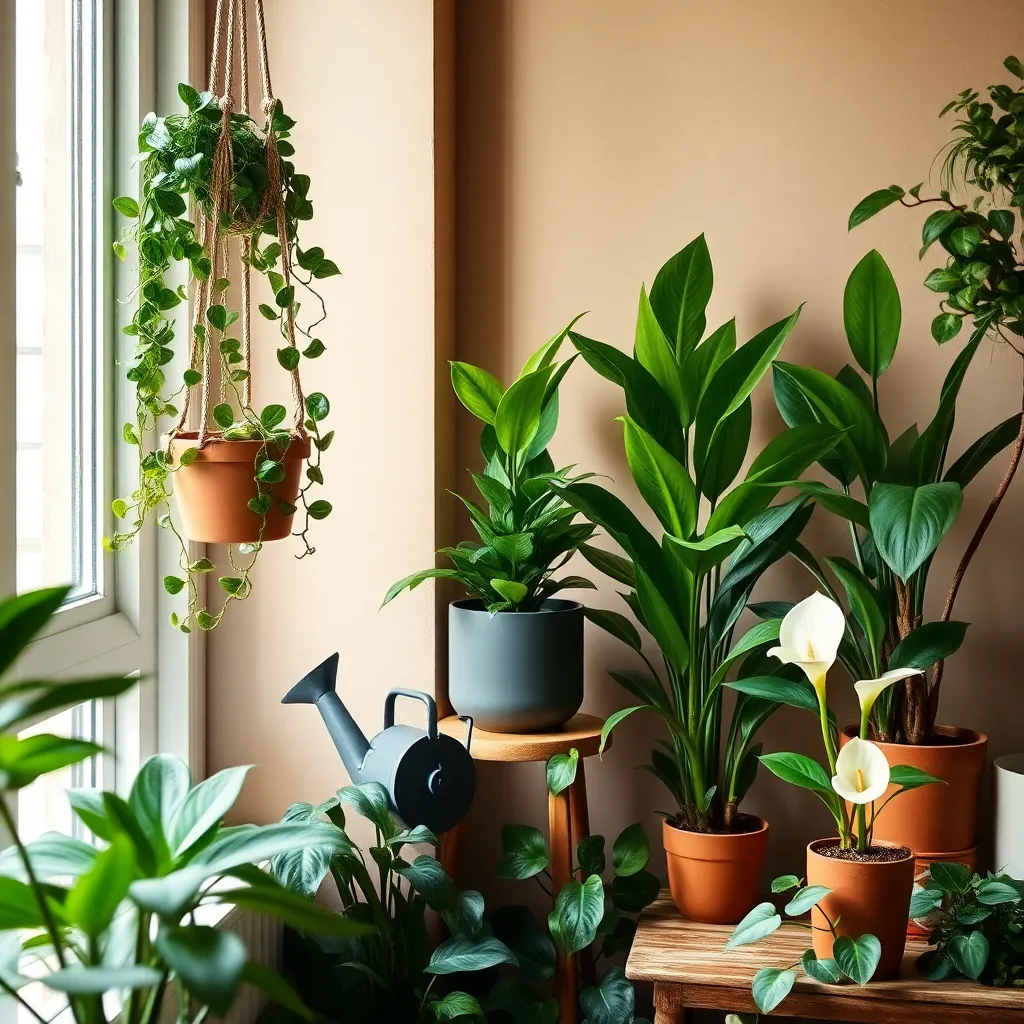In the cozy nooks of small apartments, where sunlight can be as elusive as a rare treasure, the desire to cultivate a green sanctuary may feel like a daunting task. But fear not, whether you’re a novice just beginning your green journey or an experienced gardener looking to adapt to compact living, there are resilient plants ready to thrive in the shadows of your home. These low-light warriors not only enhance your living space aesthetically but also contribute to improving air quality and boosting your mood, transforming your apartment into a sanctuary of calm and creativity.
Discovering the right plants for low-light conditions opens doors to a world of greenery that can flourish with minimal natural light. In this article, we will explore a selection of plants that are not only perfect for small spaces but also remarkably easy to care for, making them ideal companions for anyone, regardless of their gardening expertise. From the elegant peace lily to the sturdy ZZ plant, you’ll learn how to select the best options for your apartment’s unique conditions and how to nurture them to full, verdant glory.
Embracing the challenge of low-light gardening is not just about plant selection; it’s an invitation to reconnect with nature in a way that fits seamlessly into your urban lifestyle. You will gain practical insights into the specific care requirements that ensure your plants not only survive but thrive, even in the dim corners of your home. As you embark on this journey, you’ll find that cultivating greenery in your apartment isn’t just about maintaining plants—it’s about creating a living, breathing companion that brings life to your surroundings.
Understanding Low Light Conditions

Understanding low light conditions is crucial for successful indoor gardening in small apartments. These environments typically mimic the light levels found in shaded outdoor areas or north-facing windows, where direct sunlight is minimal.
To thrive in these conditions, plants generally need to be adaptable to indirect or filtered light. When selecting plants, look for those labeled as “low light” or “shade-tolerant,” as they have evolved to survive with less sunlight.
Begin by placing your plants near windows that receive indirect sunlight, as this is often the brightest spot in a low-light apartment. Rotate your plants every few weeks to ensure all sides receive equal light exposure, promoting even growth.
Soil moisture is particularly important in low-light settings, as less sunlight can lead to slower evaporation rates. Check the soil with your finger; water only when the top inch feels dry to avoid overwatering, which is a common issue in these environments.
Top Picks: Compact Low Light Plants

When space is tight and light is limited, choosing the right plants can make all the difference. Consider the Snake Plant (Sansevieria), which thrives in low light and requires watering only when the soil is dry to the touch. This plant is perfect for beginners because it’s resilient and can handle a bit of neglect.
The Pothos is another top pick for compact, low-light situations. Its trailing vines can be trained to grow upward or downward, making it versatile for any space. For best results, allow the soil to dry out between waterings and use a well-draining potting mix to prevent root rot.
Aim for the ZZ Plant if you want a truly low-maintenance option. This plant’s waxy, green leaves are not only attractive but also adept at tolerating low light and infrequent watering. Use a pot with drainage holes and a cactus mix to ensure excess water doesn’t damage the roots.
For those who enjoy a bit more challenge, try growing a Peace Lily. While it prefers indirect light, it will survive in lower lighting conditions with some adjustment. Keep the soil consistently moist but not soggy, and provide a humidity boost by misting the leaves occasionally.
When caring for these plants, remember that overwatering is a common mistake. Monitor the soil moisture with your finger and adjust your watering schedule accordingly. Consider placing these plants in rooms with north-facing windows where they can receive indirect light without the harsh rays.
Placement Tips for Limited Spaces

Maximize your small apartment’s space by utilizing vertical shelves or stackable planters to house your low light plants. This method not only saves floor space but also creates a visually appealing green wall that enhances your living area.
Placing plants near mirrors can amplify available light by reflecting it, giving your low light plants a little extra boost. This trick is especially useful in dimly lit rooms, providing an illusion of more light and space.
Consider using multi-functional furniture like plant stands with storage to keep your plants elevated and organized. These stands can hold smaller items below, making them perfect for tight spaces where every inch counts.
For beginner gardeners, setting up a watering schedule is crucial, especially in limited spaces where overwatering can quickly lead to root rot. Opt for pots with drainage holes and use a mix of peat and perlite to ensure proper aeration and moisture retention.
Veteran plant enthusiasts can experiment with placing a few plants in bathroom corners, where humidity levels are naturally higher, mimicking a tropical environment. This setup is ideal for ferns and pothos, which thrive in such conditions.
To further enhance plant health, rotate them weekly to ensure even growth, as plants naturally lean towards their light source. This simple practice prevents your plants from becoming lopsided and encourages balanced foliage development.
Care Guide for Low Light Plants

Low light plants thrive in indirect sunlight, making them ideal for small apartments with limited natural light. Place these plants near windows with sheer curtains to provide them with the right amount of filtered light.
Overwatering is a common mistake in low light conditions, as the soil tends to dry out more slowly. Check the soil moisture with your finger before watering, and only do so when the top inch feels dry to the touch.
Using the right type of soil is crucial for the health of low light plants. Opt for a well-draining potting mix, such as a blend of peat moss, perlite, and vermiculite, to prevent root rot and ensure proper aeration.
Temperature and humidity levels also play a significant role in the well-being of low light plants. Keep your plant away from drafts and sudden temperature changes, and maintain a humidity level of around 40-50% using a simple pebble tray or a humidifier.
For those looking to enhance their plant care skills, consider fertilizing low light plants sparingly. Use a balanced, water-soluble fertilizer once every one to two months during the growing season, but avoid fertilization during the dormant winter months.
Troubleshooting Common Growth Issues

Even the most resilient low light plants can encounter growth issues in small apartment settings. One common problem is overwatering, which can lead to root rot and yellowing leaves. To avoid this, ensure that your pots have drainage holes and use a well-draining soil mix, such as a combination of potting soil, perlite, and orchid bark. Water your plants only when the top inch of soil feels dry to the touch, which might mean watering every two weeks depending on your apartment’s humidity levels.
Another issue is insufficient light, which can cause plants to become leggy or lose leaves. While low light plants can tolerate shade, they still need some indirect sunlight to thrive. Consider placing them near a north-facing window or supplementing with artificial grow lights if natural light is minimal. For advanced care, rotate your plants every few weeks to ensure even light exposure and balanced growth.
Pests can also pose a challenge, especially in confined spaces where air circulation is limited. Check your plants regularly for signs of common pests like spider mites and aphids. A practical solution is to wipe leaves with a damp cloth and use insecticidal soap as needed. Additionally, maintaining good airflow by spacing plants appropriately can help prevent infestations and promote healthier growth.
Finally, nutrient deficiencies can slow down growth or cause discoloration. Feed your low light plants with a balanced, diluted liquid fertilizer every month during the growing season. Be cautious not to over-fertilize, as this can lead to a buildup of salts in the soil. For experienced gardeners, consider using slow-release fertilizers for a more controlled nutrient supply.
Conclusion: Growing Success with These Plants
In exploring the intersection of nurturing relationships and home environments, this article highlighted five key concepts: the importance of creating a welcoming space, the role of shared activities in strengthening bonds, the soothing influence of nature on stress reduction, the symbolism of growth within relationships, and the importance of adaptability in both plants and partnerships. As you reflect on these insights, consider introducing a low-light plant into your apartment as a symbol of growth and shared responsibility—an immediate step that fosters both connection and a tranquil home atmosphere.
Empower your relationship journey by saving this article as a handy reference. Bookmark it now, so you can revisit these insights and continue nurturing a loving, supportive environment at home. Looking ahead, remember that relationship success thrives on small, consistent efforts. By integrating these concepts into your daily life, you are laying the foundation for a resilient and flourishing partnership. Embrace this opportunity to grow together, and watch as both your love and your home bloom beautifully.







